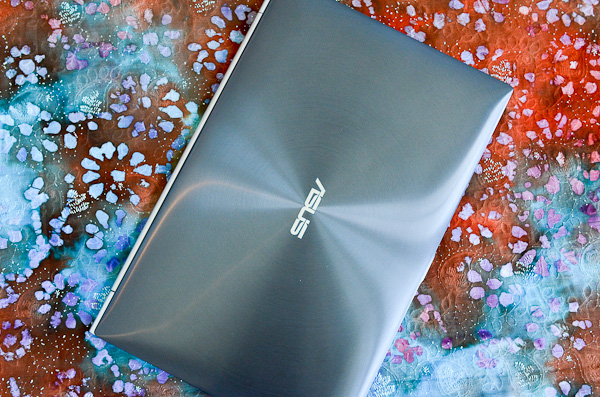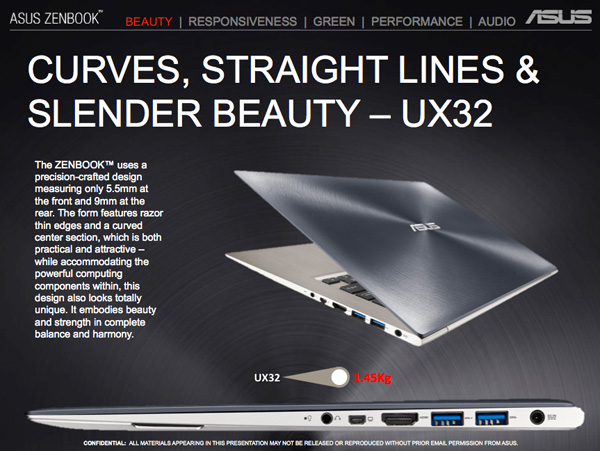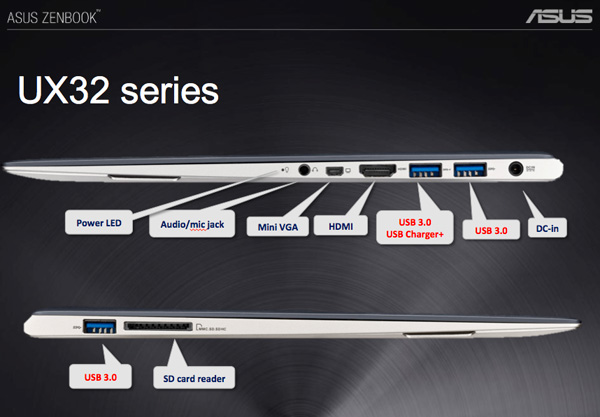ASUS Zenbook Prime (UX21A) Review: The First of the 2nd Gen Ultrabooks
by Anand Lal Shimpi on May 22, 2012 2:46 PM EST- Posted in
- Laptops
- CPUs
- Asus
- Ivy Bridge
- Zenbook
- Zenbook Prime
- Ultrabook
- Notebooks
The first round of Ultrabooks were mostly underwhelming. It shouldn't be a surprise, but many of the efforts were just half hearted at best. Of the companies who shipped the first Ultrabooks however, it was ASUS who came the closest to perfection with the Zenbook.
ASUS' Zenbook embodied the form factor, portability and overall concept of an Ultrabook. Where it failed to deliver was with its keyboard, display and, at least initially, with its trackpad. The first Zenbook was an amazing effort given the short period of time that it was conceived and developed in, but it was too rough around the edges.
Despite only being introduced 7 months ago, the Zenbook is old news. This is the Zenbook Prime:
The Zenbook Prime is ASUS' second generation Ultrabook, built around Ivy Bridge silicon. Unlike most silicon updates to notebooks however, the Zenbook Prime takes an almost Apple-like approach to renovating the tangibles rather than just relying on a faster chip to do the heavy lifting.
I don't know that I've ever seen a faster turn around on implementing reviewer and user feedback into a product. The Zenbook Prime fixes nearly every issue I had with the original Zenbook. From keyboard to display, it's all significantly better with the Zenbook Prime.
The circumstances around today's launch are a bit peculiar. Intel has an embargo in place on the as of yet unreleased Ivy Bridge CPUs, this applies to both notebooks and desktops. One such line of CPUs, the dual-core ultra-low-voltage Ivy Bridge parts that will find their way into many Ultrabooks, is covered by the aforementioned embargo. That embargo lifts at some point in the not too distant future, but ASUS wanted to have its review-ready hardware out the door and getting coverage before then. Why the urgency? It could have something to do with Apple's expected launch of updated MacBook Air and MacBook Pro systems. Rather than for Apple to get all the glory for being first, ASUS set some guidelines: we're allowed to talk about everything to do with the new Zenbook Primes, we just can't get into specifics on the CPU just yet. That's right, you won't read any model numbers, clock speeds or cache sizes here. Given what's already public about the ULV Ivy Bridge lineup I suspect this information isn't too hard to figure out if you're really motivated.

Zenbook Prime (left) vs. Zenbook (right)
The rest of the Zenbook Prime has nothing to do with Ivy Bridge. The form factor of the Zenbook Prime remains unchanged from its predecessor. Just like before we'll see two distinct models, an 11-inch (UX21) and 13-inch (UX31) in for review. With the lid closed, these two look identical to their Prime-less (composite numbered?) counterparts. ASUS sent the 11-inch Zenbook Prime in for review:
| ASUS Zenbook Prime Specs | |||||||||
| UX21A-DB5x | UX21A-DB7x | UX31A-DB51 | UX31A-DB52 | UX31A-DB71 | UX31A-DB72 | ||||
| CPU | ULV IVB | ULV IVB | ULV IVB | ULV IVB | ULV IVB | ULV IVB | |||
| GPU | HD 4000 | ||||||||
| Display | 11.6-inch 1920 x 1080 IPS | 13.3-inch 1920 x 1080 IPS | |||||||
| Memory | 4GB DDR3-1600 (on-board) | ||||||||
| Storage | 128GB U100 SSD | 128/256GB U100 SSD | 128GB U100 SSD | 256GB U100 SSD | |||||
| Wireless Connectivity | Intel Centrino N 6205, 802.11b/g/n 2.4/5GHz 2x2:2, Bluetooth 4.0 | ||||||||
| Battery | 35Wh | 50Wh | |||||||
| Camera | 720p front facing | ||||||||
| Audio | Bang and Olufsen ICEpower | ||||||||
| I/O | 2 x USB 3, 1x audio/mic, 1x microHDMI, 1x miniVGA | 2 x USB 3, 1 x audio/mic, 1 x microHDMI, 1 x miniVGA, 1 x SD Card reader | |||||||
| Dimensions | 299mm x 168.5mm x 3-9mm | 325mm x 223mm x 3-9mm | |||||||
| Weight | 1.1kg | 1.3kg | |||||||
| Price USD | TBD | TBD | $1099 | $1199 | $1499 | $1599 | |||
Pricing is still in the air as the Zenbook Prime won't be shipping until early June. I suspect much of how aggressive ASUS is on this front will depend on what Apple does in the coming weeks.
Introducing the UX32, Starting at $799
There's also a new member of the Zenbook Prime lineup, the 13-inch UX32. Featuring a thicker chassis, the UX32 will be offered as low as $799 with a 1366 x 768 TN panel, hard drive + SSD cache and as high as $1299 with a discrete NVIDIA GeForce GT 620M GPU:
| ASUS Zenbook Prime UX32 Specs | |||||||||
| UX32A-DB31 | UX32A-DB51 | UX32VD-DB71 | |||||||
| CPU | ULV IVB | ULV IVB | ULV IVB | ||||||
| GPU | HD 4000 | NVIDIA 620M + HD 4000 | |||||||
| Display | 13.3-inch 1366 x 768 TN | 13.3-inch 1920 x 1080 IPS | |||||||
| Memory | 2GB DDR3-1600 (on-board) + 2GB or 4GB SO-DIMM | ||||||||
| Storage | 7mm 320GB HDD + 24GB SSD (cache) | 7mm 500GB HDD + 24GB SSD (cache) | 7mm 500GB HDD + 24GB SSD (cache) | ||||||
| Wireless Connectivity | Intel Centrino N 6205, 802.11b/g/n 2.4/5GHz 2x2:2, Bluetooth 4.0 | ||||||||
| Battery | 48Wh | ||||||||
| Camera | 720p front facing | ||||||||
| Audio | Bang and Olufsen ICEpower | ||||||||
| I/O | 3 x USB 3, 1 x audio/mic, 1 x HDMI, 1 x miniVGA, 1 x SD card reader | ||||||||
| Dimensions | 325mm x 223mm x 5.5 - ~9mm | ||||||||
| Weight | 1.44kg | ||||||||
| Price USD | $799 | $999 | $1299 | ||||||
Depending on how well the SSD cache works, and how good the 1366 x 768 panel is, the $799 UX32A could be a very compelling system.













192 Comments
View All Comments
Pneumothorax - Tuesday, May 22, 2012 - link
Finally,my days of running bootcamp on a MBA are coming to an end!g1011999 - Wednesday, May 23, 2012 - link
Beginning of new retina display MBA?Endeavour1934 - Tuesday, May 22, 2012 - link
2 years ago when Sony first released the VAIO Z with the 1920x1080 display, they said that because the grid of pixels was more dense, it needed 25% more backlight power than the 1600x900 version in order to have the same level of brightness.Maybe the same thing happens with this new IPS display, and that may be one of the reasons why the battery life is not better than the previous generation.
saneblane - Tuesday, May 22, 2012 - link
I've yet to see what's so ultra about this. The performance is not their, the gpu sucks and they are not Apple to be selling things with not much use. Good luck with this.CaioRearte - Tuesday, May 22, 2012 - link
Sorry Intel, but it seems AMD won the slim-notebook round. Intel can't catch up on video performance at this wattage, and tons of processing power aren't exactly what a laptop owner is looking for. Since AMD has been turning towards diverse computing methods for a while, and actively dedicating more to the graphics than to raw power, their products will be more balanced and enticing in the long run.Anyway, the UX32 with the dedicated 620M looks like a good contender, when are you getting your hands on it? :)
Lilian_Anne32 - Tuesday, May 22, 2012 - link
I have the previous version of this which I bought a few months ago.... it didn't have a backlit keyboard or anything else I expected it to have, with the keyboard being annoying and all, but the laptop functions well. I was just curious if the first models are tradeable for a newer model?That extra USB port would be very useful for me right now.
TrackSmart - Tuesday, May 22, 2012 - link
Well, you certainly won't be able to trade in the older model, but you could easily sell it on Ebay when the new one comes out. If you are talking about replacing your keyboard for the backlit keyboard on the new one, I wouldn't count on it. It sounds like it has been substantially redesigned.On the plus side, you'll have enjoyed your new laptop for have a year by the time the new model comes out. There will always be a better model coming out in 6 months. Enjoy what you've got.
IntelUser2000 - Tuesday, May 22, 2012 - link
I think the improvement in battery life can be attributed to the following:-USB 3.0 controller moving from a dedicated chip to a integrated one in the HM7x PCH
-Improved software/hardware build quality. Also maybe the Sandisk SSD offers bettery battery life?
-DDR3L memory? Ivy Bridge allows DDR3L support, and I've also read that the new Zenbook uses one
kenyee - Tuesday, May 22, 2012 - link
I know it's a copy of the Macbook Air, but 4GB isn't enough for people running VMs. And you know Apple is going to increase their memory limit with the next release ;-)Love the screen though...about time they started putting high density screens in these things...
theknowhow - Tuesday, May 22, 2012 - link
Confused on the configuration versus the price on UX32.As far as I can see, the $799 vs. $ 999 device differs only in additional HDD. I would have made sense if its an SSD difference
Am I missing something here?